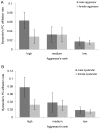Post-conflict affiliation by chimpanzees with aggressors: other-oriented versus selfish political strategy
- PMID: 21799788
- PMCID: PMC3140506
- DOI: 10.1371/journal.pone.0022173
Post-conflict affiliation by chimpanzees with aggressors: other-oriented versus selfish political strategy
Abstract
Consolation, i.e., post-conflict affiliation directed from bystanders to recent victims of aggression, has recently acquired an important role in the debate about empathy in great apes. Although similar contacts have been also described for aggressors, i.e., appeasement, they have received far less attention and their function and underlying mechanisms remain largely unknown. An exceptionally large database of spontaneous conflict and post-conflict interactions in two outdoor-housed groups of chimpanzees lends support to the notion that affiliation toward aggressors reduces the latter's aggressive tendencies in that further aggression was less frequent after the occurrence of the affiliation. However, bystander affiliation toward aggressors occurred disproportionally between individuals that were socially close (i.e., affiliation partners) which suggest that it did not function to protect the actor itself against redirected aggression. Contrary to consolation behavior, it was provided most often by adult males and directed toward high ranking males, whereas females engaged less often in this behavior both as actors and recipients, suggesting that affiliation with aggressors is unlikely to be a reaction to the distress of others. We propose that bystander affiliation toward aggressors may function to strengthen bonds between valuable partners, probably as part of political strategies. Our findings also suggest that this post-conflict behavior may act as an alternative to reconciliation, i.e., post-conflict affiliation between opponents, in that it is more common when opponents fail to reconcile.
Conflict of interest statement
Figures



References
-
- Trivers RL. Parental investment and sexual selection. In: Campbell B, editor. Sexual Selection and the Descendent of Man. Chicago: Aldine; 1972. pp. 136–179.
-
- Clutton-Brock TH. Mammalian mating systems. Proc R Soc Lond B Biol Sci. 1989;236:339–372. - PubMed
-
- van Schaik CP, van Noordwijk MA. The hidden costs of sociality: Intra-group variation in feeding strategies in Sumatran long-tailed macaques (Macaca fascicularis). Behaviour. 1986;99:296–315.
-
- de Waal FBM. A natural heritage of conflict resolution. Science. 2000;289:586–590. - PubMed
-
- Aureli F, Cords M, van Schaik CP. Conflict resolution following aggression in gregarious animals: a predictive framework. Anim Behav. 2002;64:325–343.
Publication types
MeSH terms
Grants and funding
LinkOut - more resources
Full Text Sources

